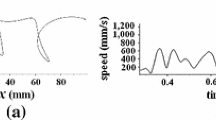Abstract
One of the primary goals of handwriting modeling is to understand how humans represent, control and generate compex movements. Moreover handwriting modeling has been also used for practical applications such as handwriting analysis and recognition. Numerous models used to date were not strong enough to explain and support some fundamental results about biomechanical or neurophysiological systems and neither practical enough to be used for accurate handwriting generation in the kinematic and the spatial domains. The vectorial delta lognormal model has been shown, in the past few years, to answer to these two paradigms showing accuracy for simple movements simulation and flexibility for letters and cursive handwriting generation. In this paper we show how this model can help to study handwriting variability, particulartly, the effects of the fluctuations of the commands and of the neuromuscular effectors, on the movement generated. Some characters models are proposed with examples of the variability effects. A parametric representation of allographs can then be used to represent basic shapes and some models of distortion, to generate a variety of prototypes.
Preview
Unable to display preview. Download preview PDF.
Similar content being viewed by others
References
Bullock D., Grossberg S., Mannes C., (1993) “A Neural Network Model for Cursive Script Production”, Biological Cybernetics, 70, 15–28.
Guerfali W., Plamondon R., (1995) “The Delta-Lognormal Theory for the Generation and Modeling of Cursive Characters”, Proc. 3rd Int. Conf. on Document Analysis and Recognition, 495–498.
Guerfali W., Plamondodn R., (1995) “Control Strategies for Handwriting Generation”, Proc. 7th Biennial Conference of the International Graphonomics Society, 64–65.
Guerfali W., (1996) “Modèle delta-lognormal vectoriel pour l'analyse du mouvement et la génération de l'écriture manuscrite”, Ph.D. Dissertation, École Polytechnique de Montréal.
Guyon I., Makhoul J., Schwartz R., Vapnik V., (1996) “What Sise Test Set Gives Good Error Rate Estimates?” Fifth International Workshop on Frontiers in handwriting Recognition, 313–316.
Morasso P., Sanguineti V., Tsuji T., (19940 “A Model for the Generation of Virtual Targets in Trajectory Formation”, Adevences in Handwriting and Drawing: A Multi disciplinary approach, Faure C., Keuss P., Lorette G., Vinter A. Eds., 333–348.
Plamondon R., Maarse F.J., (1989) “An Evaluation of Motor Models of Handwriting”, IEEE, Trans. on Systems, Man and Cybernetics, v. 19, n. 5, 1060–1072.
[PLA-93a] Plamondon R., (1993) “ The Generation of Rapid Human Movements. Part I: A Delta Lognorma law”, Technical Report ERM/RT-93/4, École Polytechnique de Montréal.
Plamondon R., (1993) “ The Generation of Rapid Human Movements. Part II: Qudratic and power laws”, Technical Report ERM/RT-93/5, École Polytechnique de Montréal.
Plamondon R., (1995) “A Kinematic Theory of Rapid Human movements. Part 1: Movement Representation and Generation”, Biological Cybernetics, 72:297–307.
Plamondon R., (1995) “A Kinematic Theory of Rapid Human movements. Part II: Movement time and Control”, Biological Cybernetics, 72:309–320.
Plamondon R., (1995) “A Delta Lognormal Model for Handwriting Generation”, Proc. 7th Biennial Conference of the International Graphonomics Society, 126–127.
Plamondon R., Guerfali W., (1996) “Why Handwriting Segmentation Can Be So Misleading?”, Proc. 13th Int. Conf. on Pattern Recognition, 396–400.
Plamondon R., Guerfali W., (1996) “The Generation of Handwriting with Delta-Lognormal Synergies”, Paper submitted for publication to Biological Cybernetics.
Plamondon R., (1996) “A Kinematic Theory of Rapid Human Movements. Part III: Kinetic Outcomes”, Paper submitted for publication to Biological Cybernetics.
Singer Y., Tishby, N., (1994) “Dynamical Encoding of Cursive Handwriting”, Biological Cybernetics, 71, 227–237.
Stettiner O., Chazan D., (1994) “A Statistical Parametric Model for Recognition and Synthesis of Handwriting”, 12th Int. Conf. on Pattern Recognition, v. II, 34–38.
Author information
Authors and Affiliations
Editor information
Rights and permissions
Copyright information
© 1997 Springer-Verlag Berlin Heidelberg
About this paper
Cite this paper
Guerfali, W., Plamondon, R. (1997). Effect of variability on letters generation with the vectorial delta-lognormal model. In: Murshed, N.A., Bortolozzi, F. (eds) Advances in Document Image Analysis. BSDIA 1997. Lecture Notes in Computer Science, vol 1339. Springer, Berlin, Heidelberg. https://doi.org/10.1007/3-540-63791-5_5
Download citation
DOI: https://doi.org/10.1007/3-540-63791-5_5
Published:
Publisher Name: Springer, Berlin, Heidelberg
Print ISBN: 978-3-540-63791-2
Online ISBN: 978-3-540-69646-9
eBook Packages: Springer Book Archive




